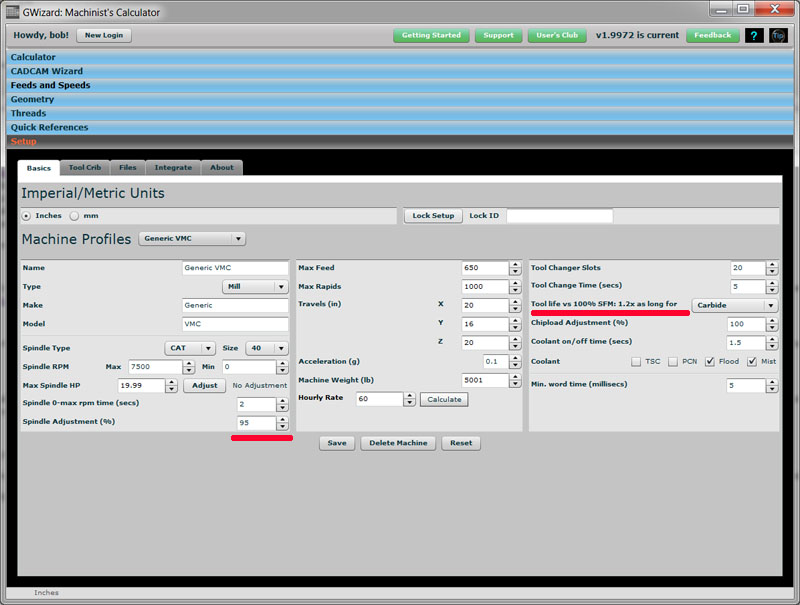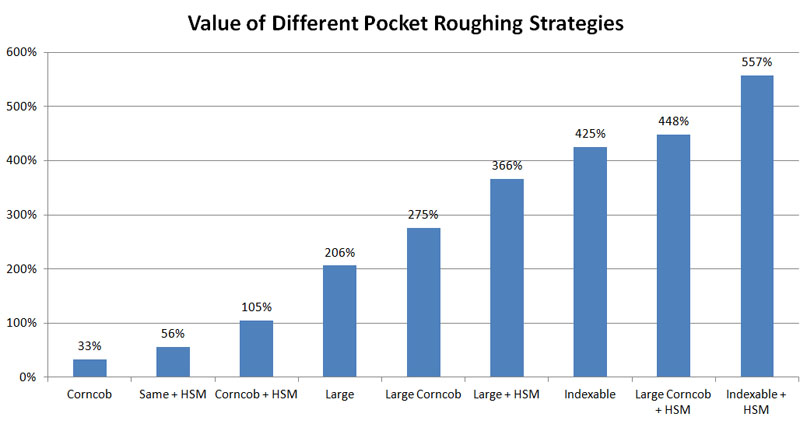This guide will show you 11 ways to radically increase your tool life and reduce tool wear. Plus it will explain the details and mechanisms of tool wear, discuss how to calculate tool wear, and describe tool life monitoring.
11 Tips to Increase Tool Life and Reduce Tool Wear
I just got a note from a G-Wizard Calculator customer wanting to know how to maximize his tool life and reduce tool wear. He’s doing long production runs and wants to keep the spindles turning as much as possible. It was a good reminder that this is a topic on a lot of machinist’s minds so here are 11 tips to increase your tool life with lots of links to even more in-depth information in each area:
1. Use the Right Feeds and Speeds
I have to start right here with using the right feeds and speeds. I can’t help it–I sell a Feeds and Speeds Calculator. There are a lot of ways to go wrong with Feeds and Speeds, even for experienced machinists:
- If you’re thinking you can go by how the cut sounds, you’re making a big mistake.
- If you’re thinking you can’t possibly go wrong by just slowing things way down, you’re making a big mistake (that cutter will start rubbing before you know it).
- If you think you can just read the best feeds and speeds out of a handbook or tooling catalog, you’re making a big mistake.
- If you’re thinking CNC feeds and speeds are just like manual feeds and speeds, (yep, you guessed it) you’re making a big mistake.
- If you think your CAM program will give you good feeds and speeds, you’re making a big mistake.
You need to be using a Feeds and Speeds Calculator, even if it isn’t mine (you know it hurts me to say that, but it’s true).
2. Keep Deflection Under Control
Deflection kills endmills, sometimes in surprising ways, and especially carbide endmills since they’re brittle and don’t bend as easily as HSS endmills. Most machinists are unaware how much deflection they’re running until it gets too far out of hand. But, a good Feeds and Speeds Calculator will tell you how much deflection your cut parameters will generate. A great one will help you optimize your cut parameters within deflection limits. Also, when you’re setting up tools for use in many jobs, use as little Tool Stickout as possible.
3. Avoid Recutting Chips
I tell everyone I can to be paranoid about recutting chips. Make sure the coolant is set up to get rid of them. Sometimes flood coolant turns into “dribble” coolant because machines lack full enclosures and the machinist wants to avoid a mess. Use mist for those machines as the dribble just covers up the chips sitting in the cut so you can no longer see them.
4. Lubricate Sticky Materials
Built up edge or “BUE” is the technical term. Some materials have an affinity for what cutters are made of and they will weld chips onto the cutting edge which quickly results in a broken cutter. Aluminum is one such, but there are a lot of others. Look up the material and if it is prone to chip welding, you need lubrication. You can get it from flood coolant, mist coolant, or some tool coatings. What you can do is machine materials prone to chip welding without it.
5. Add a Surface Speed Safety Factor
Given a choice between reducing surface speed (SFM or spindle rpms) and reducing chip load, surface speed is the one to go after for tool life unless you’re breaking relatively new cutters, in which case you need to reduce chip load.
A slight reduction in surface speed can yield big dividends for tool life. Surface speed is all about how hot the tool can run and reducing it lowers the heat. Heat softens the cutting edge which means it dulls faster. You can see why reducing heat even a little can really increase tool life substantially.
G-Wizard Calculator has the ability on every machine profile to specify a multiplier for the calculated surface speed. It’ll even tell you how much more tool life you can expect:

Reducing Surface Speed 5% can increase tool life 20%…
6. Dial Back the Tortoise-Hare Slider
G-Wizard has a feature we affectionately call the “Tortoise-Hare” slider:
![]()
The Tortoise-Hare slider can be used to emphasize either Material Removal Rate (“Hare” end) or Surface Finish and Tool Life (“Tortoise” end). Try dialing back more towards the Tortoise end when you’re particularly concerned about Tool Life. What that will do is reduce both the Surface Speed and the chip loads, although it reduces chip load the most.
7. Use a Gentler Cut Entry in Your CAM Program
A lot of cutter wear starts on entry to the cut. You may even chip the edge there, especially in tough work-hardening materials. The solution to this problem is to adopt gentler entries. Avoid plunging the cutter. Instead, use one of these strategies:
– Ramp in, with a relatively gentle ramp.
– Helix or spiral in.
– Use a decent-sized indexable drill to create a hole for entry.
– For profile cuts and surfacing, arc into the cut.
We talk about all this and more in my Toolpath Considerations article from my Feeds and Speeds Cookbook.
8. Be Gentle Exiting the Cut Too
The other reason to check out that toolpath article is that how you exit the cut matters too for tool life.
9. Rough With Tougher Tools
Are you roughing with the same endmill you will use for finishing? Same size and geometry anyway?
There are better approaches. Use a bigger tougher tool for the roughing. Indexable endmills and corncob roughers can take a lot more abuse than solid endmills. I’ve got a whole article for you on some of the tradeoffs when you’re roughing, but here’s a summary chart:

10. Spread Wear Over the Cutting Edge
Are you keeping your cut depths super shallow thinking that’ll mean you’re taking it easy on the cutter? Well, you are taking it easy, but unfortunately you’re also concentrating all the wear on the tip of the flutes. They can only last so long that way. What you need to do is spread that wear over as much of the flute as you can by increasing cut depths. You’ll have to back off cut width as a tradeoff and you’ll have to watch out for excessive deflection, but once you have those two under control, you’ll get a lot more life out of your cutters. This has another benefit in that it gives the flutes more “air cutting” time per revolution, which makes it easier for them to cool down as well as to get rid of chips. It can really turn down the heat in your cut, in other words.
11. Minimize Runout
Runout is a nasty business for cutters. It’ll break tiny micromachining cutters in a heartbeat. Larger cutters it just wears out prematurely. Many tooling manufacturers estimate every tenth (0.0001″) of spindle runout reduces tool life by 10%. That’s significant!
Often, runout may not even be the fault of the spindle. It could just be that you’ve got a toolholder that’s out of whack. You can measure your toolholders to see if you have that problem, and you can even “clock” them in to minimize runout.
If we’re talking turning instead of milling, runout still exists. Misalignment of a twist drill versus the centerline of the axis is identical to runout on a mill. Check out my article on just how accurately you should be setting your turning tools relative to the lathe’s centerline for more.
Types of Tool Wear
Flank Wear
Flank Wear is wear on the portion of the tool in contact with the finished part. It’s the most common type of Tool Wear and the most predictable. It occurs due to abrasion of the tool by the workpiece. Harder workpiece materials will be more abrasive.
As flank wear increases, cutting forces will increase as well.
Crater Wear
Crater Wear occurs when chips strike and erode the rake face. It takes quite a lot of crater wear to degrade the effectiveness of a tool.
Built Up Edge
Built Up Edge, often abbreviated as BUE, occurs when the material being machined builds up on the cutting edge. Materials like aluminum and copper have a tendency to weld themselves to the cutting edge of a tool. It can be prevented by increasing cutting speeds and using lubricant (coolant).
Notch Wear
Notch Wear is wear that appears right at the depth of the cut line. It is caused by adhesion (pressure welding of chips) and a deformation-hardened surface. It is common when machining stainless steels.
Thermal Cracks
Thermal Cracks are tiny cracks along the cutting edge caused by shock cooling. They’re related to interrupted cuts and are aggravated by coolant.
Edge Chipping
Edge Chipping is caused by an overload of mechanical tensile stresses. Chip hammering, too much depth of cut, sand in the workpiece, BUE, and vibration (chatter) are all possible causes. The method of entering the cut also has a large effect on Edge Chipping.
Tool Life Definition
Tool Life can be defined in several ways including:
- The total volume of material removed with the tool during its life.
- The duration for which the tool is usable for machining, usually expressed in minutes.
- The number of parts the tool can be used to produce.
If a tool breaks, clearly it has reached the end of its life. But most definitions are focused on a more gentle end to the tool. For example, we may define maximum acceptable flank wear, perhaps a value of 0.5mm.
Tool wear is usually not uniform. The wear on a new tool is accelerated, then settles down to a more normal rate, then towards the end the rate of wear goes up again until the tool finally fails catastrophically. Since a catastrophic failure can often mean scrapping the part, this is why we prefer to identify the end of a tool’s useful life before a catastrophic failure.
Tool Life Calculation
In 1907, F.W. Taylor developed an equation that expresses the relationship between tool life and cutting speed (temperature) while keeping feed rate constant.
Taylor’s Tool Life Equation
Taylor’s Equation for Tool Life is:
Where
=cutting speed
- T=tool life
- D=depth of cut
- S=feed rate
- x and y are determined experimentally
- n and C are constants found by experimentation or published data; they are properties of tool material, workpiece and feed rate. For example, n is 0.1 to 0.2 for HSS tools, 0.2 to 0.4 for carbide, and 0.4 to 0.6 for ceramic.
One of the main practical takeaways from the equation is that Cutting Speed is a much bigger determinant of tool life than feed rate. All other things considered, increasing cutting speed causes twice as much wear as increasing feed rate by the same percentage.
Depth of cut will also increase wear, but the effect is even less than increasing feed rate. Also, the increased wear of depth of cut is offset by spreading the overall wear over a longer length of cutting edge. That’s the principal between High Efficiency Machining.
Conclusion
Phew! This has been kind of an Omnibus article just because there are so many factors affecting tool life, and so much content already on the site that I wanted to refer you to. Hope that helps, and if you have any tips of your own to help increase Tool Life, let us know in the comments.



